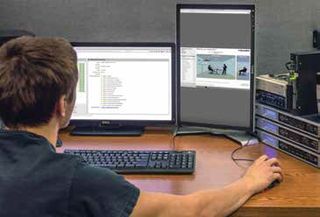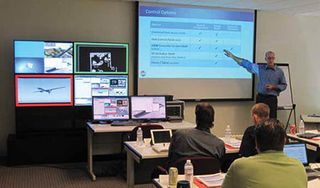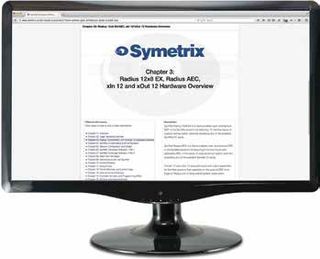
Roland’s hands-on reseller training in Vancouver, B.C. Canada. Sometimes it’s good practice to blur your lines.
Take the field of end user-focused training initiatives. With variables such as audience expectations and presentation preferences, the means are many but designed to reach a common goal: to benefit the integrator.
Vaddio’s consultant liaison, Todd Bergum, summed it up simply: “An educated end user provides an intelligent customer for the integrator.”
“If an integrator is interfacing with an end user who knows, in general, what he or she wants to accomplish but has no knowledge of the varying solutions or the available technology, then the integrator must hold his or her hand and lead him or her down the path from the most elementary starting point,” added Bergum, who also handles Vaddio’s in-house sales training.
Most end users now have at least some degree of knowledge of computers, smartphones, tablets, and other personal networking platforms, but the AV technology solutions that integrators need to interface with these platforms aren’t always as familiar.
“We first need to learn how deep the end users’ knowledge goes on these platforms, so we know how to educate them on the AV solutions they communicate with,” he said. “If we can build a multi-microphone, echocancelled audio system, and a high-end PTZ camera solution that ends up in the USB domain, we can explain how the user’s computer and app think of this as just an external webcam, mic, and speaker. It’s much more than that, but having a fundamental understanding to this level can make the road to the right solution faster and more satisfying to all parties.”
Be the Bridge

Symetrix created a series of in-person training sessions to help end users with its products. At RGB Spectrum, integrators are provided with installation and configuration training, but they are also versed in the operational aspects of each product, said Paul Berliner, product marketing manager. “Once a system is commissioned and the customer is able to create his or her wall layouts and fine tune his or her new workflows, it is imperative that the integrator is able to bridge that gap between operations and engineering,” he said. “Beyond the nuts and bolts of putting images on screen, our training allows the installer to more fully understand the customer’s usability requirements.”
Requests for end user-focused training are coming from several directions: from sales reps, distributors, and integrators, said Brooke Macomber, managing director of global sales and marketing at Symetrix.
“Rather than focusing on system design and integration, Symetrix has created a series of in-person, end user training modules that answer the question, ‘Why digital signal processing (DSP)?’ and explain the benefits to end users in very specific application verticals,” she said. “The problem/solution format in specific applications can be very useful for end users when deciding on their final system requirements.”
Roland Pro A/V division marketing manager, Rob Read, said the company offers both end user and reseller consultant training for its products. “These courses cover both product operational training, as well as principles of system design. Some disciplines could include live video mixing, video format conversion, live digital audio console mixing, personal and monitoring mixing, and multi-channel recording. These disciplines are not product specific and can provide an overview to a reseller, consultant, or end user. Our training courses, whether online or hands on, can help the user apply a discipline learned to one of our products in a live application.”
At the Core
Although there is no complete hybridization of training style for a target audience, most audience members need to know the core points, Bergum said. These include answers to the following questions: What is it, how does it work, what markets does it serve, what are some specific applications in these markets, and what’s the value proposition for this solution?

RGB Spectrum provides integrators with installation and configuration training to help them fine-tune their layouts. “These are important to any audience,” Bergum said. “But beyond that, the needs are different. The end user audience generally doesn’t need to know how much gain is available in a mic preamp or what the frame rate is for a camera using a specific soft codec.”
And just as there are no cookie-cutter system installations, no two training classes are alike because the mix of students within the audience varies greatly. “For example, we provide a highlevel ‘solutions’ training, given via Webex, but the presentation varies depending if the audience is the sales department, the engineering department, the systems integrators, or the finance department,” Berliner said. “Depending on the audience, the language can vary from highly technical to simple layman’s terms, with the goal of ensuring that concepts and key information are conveyed in a clear, concise manner. So in short, yes, every class is a hybrid.”
“A modular, on-demand approach to training is key,” added Macomber. “This allows the flexibility to cater to the audience’s training needs, which can be very different depending on their application focus. In addition to manufacturer product and software training, companies like SynAudCon do a wonderful job of educating on audio fundamentals, which can be a great complementary resource for any comprehensive training program.”
And often resellers can benefit from end user training because it provides them with a foundation of product operation, so they can help customers use the product effectively for their applications, Read noted. “Roland University is an online training program for our authorized resellers containing video tutorials with questions and answers at the end of each section to test the knowledge that they just learned,” he said. “Course data is saved for each participant and updated in our contact manager program. We then know in each company who has taken and passed our online courses at Roland University.”
Roland’s multi-part, online video tutorials are designed to help end customers and resellers get started in using its products. Its Roland VR-50HD seven-part video training series is organized to help them navigate the different operational sections of products by subject. “If someone is having trouble with audio using the Roland VR-50HD, they can easily jump to that tutorial, which walks them through setup and operation without having to go through the entire training video content,” he said. “If someone is new, they can go through all seven tutorials.”

Symetrix offers detailed online training for its products. All of RGB’s courses are given in person, either in the classroom or via Webex, Berliner said. “We currently do not offer online training because the level of interaction between student and teacher is a key element in the success of these courses. Y ou can’t raise your hand in an online course and get answers to a specific question regarding your system design.”
Macomber made a case for both options being equally necessary. “Online training allows for on-demand, 24/7 solutions, and many times, it can be used as a complementary resource to technical support, while in-person training allows for a more interactive hands-on approach that can be designed to meet specific audience needs and application verticals.”
A Delicate Balance
In weighing the delivery options for training, in person or online, there are several considerations, including specific personal preferences.
“We give this subject a great deal of attention in our new international age of diversity and acceptance,” Berliner said. “On our request forms, we ask if any students have special dietary requirements, and we are very happy to accommodate. Within the class itself, many students have different agendas depending on the information they need. We take special care in addressing each and every question and concern, and our in-house technical services organization ensures that every student has a one-on-one discussion to review his or her system design.”
It’s human nature to prefer to gain what knowledge is needed as quickly as possible, so for broad subjects that simply communicate “here’s this new thing, and here’s how it works,” an online video description is always great, explained Bergum. “But, with high-tech integrated systems or solutions that require programming and technical understanding, a simple online video simply won’t suffice,” he said.
Symetrix offers the full spectrum of training options from in person, to webinars, to self-paced video tutorials that allow partners to increase their competency across solutions, Macomber noted. “By understanding how to use the products effectively with real world applications, partners can select the training courses to build competencies that complement their overall partner strategies and application focus,” she said.
Roland also feels very strongly about online, as well as hands-on training. “Online training can get someone up and running very quickly on the operation of one of our products,” said Read. “Our hands-on training can provide a deeper level of knowledge, as well as basic principles within a discipline.”
The bottom line? Online, live interactive training is certainly more effective if the audience isn’t too big and has the opportunity to chime in with its questions and input, Bergum noted, and it’s the best way for people to experience online solutions from the standpoint of the faraway end user.
“Still, none of these methods allow a hands-on experience with the equipment or the benefit of the in-person dynamics that can’t be completely simulated,” Bergum concluded. “Today’s AV manufacturers need to embrace all these forms of educating their audiences. When it comes to educating and certifying integrators to design, install, and integrate hi-tech solutions, there’s often no alternative as effective as onsite, face-to-face, hands-on training. As technology continues to accelerate, training and education will become more and more critical in our industry.”
—KM













